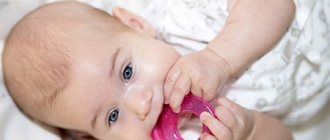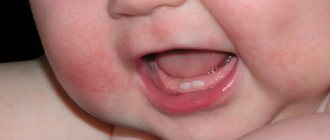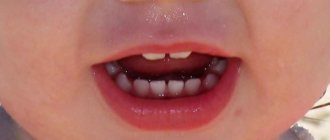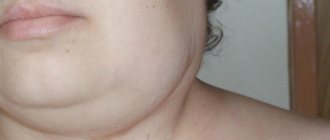Timing and symptoms of teething
In most cases, the first milk teeth erupt closer to six months, in the period from 4 to 7 months, but there is no single correct time for the start of their growth - everything is individual. Read more about the timing and order of teething→
Timing of eruption and factors influencing them
Often the sequence of appearance, the age at which growth begins and the duration of teething in children are laid down in utero during the formation of the fetal jaw (at 3-4 months of pregnancy). During this period, their size and structure, sequence and age of appearance of the first signs of growth are determined.
Therefore, the course of pregnancy during this period and the absence of unfavorable factors that could change their normal formation are of great importance. The greatest negative impact can be caused by:
- severe maternal illness;
- late toxicosis;
- neuro-allergic disorders;
- metabolic disorders;
- exposure to harmful factors on the embryo (smoking, alcohol, drugs, radiation, poor environmental conditions);
- genetic abnormalities of fetal development;
- intrauterine infection of a child;
- heredity - family predisposition to early and late tooth growth;
- climate features;
- somatic or infectious diseases in the baby.
Symptoms of teething in babies
Symptoms preceding the appearance of the first teeth can be detected long before their true eruption - from 3-4 months. During this period, the baby experiences active salivation, moodiness, and sometimes the gums change before teething - there is slight swelling, looseness, bumpiness and slight redness.
At the same time, the child puts his hands and various objects into his mouth, and his behavior becomes restless, especially in the evening and at night. This is considered the beginning of the passage of bone paths in the gum and the approach of the tooth to the mucous membrane.
Subsequently, repeated redness and swelling of the gums are observed and the following may appear:
- light, clear mucous discharge from the nose (snot);
- rare coughing;
- temperature increase;
- loosening of stool.
Uneven gums in a child
Many parents, seeing that their child has uneven gums, worry whether the baby will grow crooked teeth. However, irregularly shaped gums are usually caused by an abnormal chin shape - a positional deformity of the chin.
This rare phenomenon is the result of pressure on the chin for a long time during fetal development. For example, a child's growing chin was located for a long time on his shoulder or on the mother's pelvic bone. This defect is similar to head deformities in newborns. The side of your baby's cheek that hasn't been pressed may appear fuller.
The good news is that chin positional deformity usually does not cause any consequences and is temporary. The chin almost always straightens on its own.
What do gums look like when teething?
By the time the baby is born, the crowns of all his baby teeth are fully formed and are located deep in the alveolar processes of the upper and lower jaw. The process of eruption is a kind of increase in their volume with gradual pushing out.
At the same time, they first overcome the resistance of bone tissue, and then the soft mucous membrane. It is at this time that the gums swell during teething, itching and pain appear at the site of their growth.
What do gums look like before teething? In normal condition, they are pale pink in color for infants. There are no changes (swelling, lumpiness, bleeding, plaque).
In most cases, the eruption picture looks like this:
- During teething in infants, the gums first become loose, a slight bumpiness and redness of the mucous membrane appears. The baby becomes restless, sleeps poorly and refuses to eat. In some cases, external manifestations may be absent - it all depends on the pain threshold and the degree of discomfort in the oral cavity.
- After a certain period of time, swollen gums become more sensitive during teething, a slight hemorrhage appears, and then a small wound forms at the site of growth and the tip of the tooth crown appears.
A small bruise on the gum during teething is not a reason to panic. In most cases, this phenomenon goes away completely as soon as the baby’s tooth approaches the surface of the tissue.
How babies teeth cut, signs
- The first sign that a baby is about to grow a new tooth is redness and inflammation of the gums. The baby begins to put everything that comes into his hands into his mouth, because his gums itch, and the baby constantly wants to chew something.
- At the same time, salivation increases, which stops after the appearance of the first few teeth. During sleep, it is convenient to place a diaper folded several times under the baby's head so that the bed linen does not get wet due to saliva.
- Due to pain in the mouth, infants often lose their appetite. This usually happens just before the tooth erupts, when the pain is greatest due to the gum breaking. As soon as the baby's first tooth erupts, the baby's appetite returns to its previous level.
- A cough and runny nose can also be a sign of teething, because due to the abundance of saliva and inflammation of the gums, the airways and nasopharynx can become inflamed. If the runny nose and cough disappear after the tooth appears, there is no reason to fear infection. Sometimes digestive disorders: diarrhea or constipation are also associated with teeth growth.
- Increase in temperature for several days. To determine whether an increase in temperature is associated with teething, you need to determine how long the fever lasts and at what level. The growth of teeth usually does not lead to an increase in body temperature above 38 degrees, which lasts no more than 2-3 days. If your baby has a higher fever for more than three days, you need to contact your pediatrician to diagnose the infection and select the right medications for treatment.
At the end of the article you can download a diagram for changing your child’s baby teeth!
Possible complications
In some cases, complications during the growth of baby teeth are possible. These include:
- Blue gums in a child during teething and/or bruising. These signs indicate the difficulty of teething in the area of the soft mucous membrane - the gums turn blue during teething, a hematoma and persistent swelling of the soft tissues appear. The baby experiences severe pain, does not sleep and constantly behaves restlessly.
- Attachment of infection. Signs of a local infectious process (viral, bacterial or fungal flora) on the mucous membrane of the gums at the site of eruption and in the oral cavity include:
- white or grayish-yellowish coating;
- rashes in the form of millet grains;
- minor erosions.
Gingivitis in children: is there any cause for concern?
Gingivitis is an inflammation of the gums, a periodontal disease, which, unfortunately, very often occurs in young children. The reasons for this can be located both in the oral cavity and in the baby’s body.
Children may experience the following forms of gingivitis:
- catarrhal;
- hypertrophic;
- ulcerative;
- herpetic;
- eruption gingivitis.
How to reduce discomfort?
Methods to reduce discomfort during teething are different and their effect is individual. Often used:
- special anesthetic gels containing various local anesthetics (Dentinox, Kalgel, Bobodent and others);
- teethers (various models made of soft plastic, filled with water), which reduce discomfort but do not injure the mucous membrane;
- in case of severe anxiety and pain, the use of painkillers with ibuprofen and paracetamol (suppositories or syrup) in an age-appropriate dosage is allowed;
- the use of anti-inflammatory decoctions of medicinal herbs - treating the gums with a soda solution, a decoction of sage, chamomile or oak bark.
Inflammatory gum disease in children
Gums can become inflamed in newborns and adult children. The most common causes of gum disease:
- improper oral hygiene;
- nutritional deficiencies (lack of vitamins and microelements);
- problems with nasal breathing;
- infectious diseases.
Read also: How to treat stomatitis in a 2-year-old child
Insufficient oral hygiene creates a favorable environment for the development of bacteria. During infectious diseases, pathogens enter the oral cavity from parts of the respiratory system. If nasal breathing is impaired, the child begins to breathe through the mouth. The mucous membranes dry out, and the antibacterial function of saliva is impaired. This leads to active proliferation of microorganisms.
Causes of gum inflammation
Sometimes gum inflammation in young children is associated with eating soft foods. There is no chewing load on the gums. When teeth appear, it is necessary to give the child solid food - apple slices, pears, bread crusts.
Precautionary measures
If any alarming symptoms appear (blue gums during teething, severe hemorrhage, increased bleeding), you should contact a pediatric dentist. Sometimes a dissection of the mucosa is required to allow tooth growth.
Under no circumstances should you independently dissect or even massage the area of hemorrhage, especially if the hematoma on the gum during teething is observed over a large area and there is pronounced swelling of the surrounding tissues.
To avoid infectious complications, you need to regularly boil in a soda solution or wash all objects that the baby puts in his mouth (pacifiers, teethers, toys).
If you notice symptoms of infection, you should urgently seek advice from a specialist. During this period, children experience a persistent decrease in local and general immunity, and improper treatment of infectious complications or lack of treatment can lead to dangerous complications.
Author: Olga Sazonova, doctor, especially for Mama66.ru
Gingivitis in children: causes
The causes of the disease are usually divided into general and local. Local reasons include:
- insufficient hygiene;
- abnormalities in the attachment of the frenulum of the lips or tongue;
- malocclusion;
- the presence of pathogenic microflora in the oral cavity;
- reduced immunity;
- changes in the composition of saliva.
Common factors include somatic diseases, one of the first manifestations of which may be gingivitis:
- diabetes;
- decreased or increased thyroid function;
- childhood neuropathy;
- heart diseases.
Read also: Treatment of stomatitis in children 3 years old
If gingivitis occurs, you should not immediately suspect these diseases, but you need to take your child to the doctor for a correct diagnosis.
Useful video: what should you avoid scratching your gums when teething?
We recommend reading: Teething in children - everything parents need to know
Author
Olga Sazonova
Pediatrician
Graduated from Lugansk State Medical University with a degree in pediatrics. Work experience in the specialty – 20 years. Currently working as a pediatric endocrinologist. He understands issues of gynecology and pregnancy, psychology. All articles by the author
I like!









